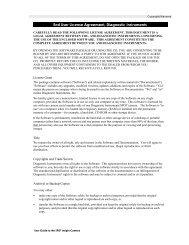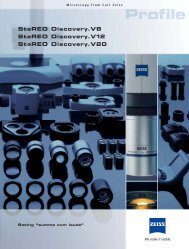optical interference filters - SPOT Imaging Solutions
optical interference filters - SPOT Imaging Solutions
optical interference filters - SPOT Imaging Solutions
Create successful ePaper yourself
Turn your PDF publications into a flip-book with our unique Google optimized e-Paper software.
QuantaMAX and Standard Filters<br />
for Fluorescence<br />
Our fluorescence filter product line is comprised of Stock QuantaMAX and Standard Vivid and Basic<br />
excitation, emission and dichroic <strong>interference</strong> <strong>filters</strong>, and filter sets.<br />
For the visualization of fluorescence and imaging from deep UV absorbing compounds such as the aromatic amino acids Tyrosine<br />
and Tryptophan, to near IR absorbing dyes such as Indocyanine Green (ICG) Omega Optical offers a variety of <strong>interference</strong> <strong>filters</strong><br />
and filter sets We have an impressive history of collaborating with researchers to identify <strong>filters</strong> that are uniquely compatible with<br />
specific fluorophores, as well as <strong>filters</strong> that are effective for fluorophores in a particular experimental design and <strong>optical</strong> set-up.<br />
These products are produced utilizing our multiple coating technologies, ion- assist, magnetron sputtering and physical vapor<br />
deposition, to best match the filter specifications to the application.<br />
QuantaMAX - Stock Interference Filters<br />
QuantaMAX are individual excitation, emission and dichroic<br />
<strong>filters</strong> and filter sets designed around the most commonly used<br />
fluorophores used in fluorescence detection and imaging.<br />
QuantaMAX (QMAX) <strong>filters</strong> are engineered and manufactured to<br />
meet the increased demands required of today’s imaging systems.<br />
Fluorophore Optimized:<br />
Organic fluorophores, whether a small molecule such as a<br />
cyanine dye, or a larger mass protein, such as e-GFP, absorb<br />
and emit photons in a highly wavelength dependent manner. This<br />
characteristic of a fluorescent compound can be illustrated by its<br />
specific fluorescence spectral curve, which describes the relative<br />
probabilities of the absorption and emission of photons across the<br />
wavelength spectrum. Figure 1 shows the excitation and emission<br />
curve for Cy5. This fluorophore is widely used in fluorescence<br />
techniques and exhibits an excitation absorption maximum at<br />
649nm and emission maximum at 670nm. The slight separation of<br />
the two is called the Stokes shift and provides a spectral “window”<br />
through which researchers can (through the use of the appropriate<br />
<strong>interference</strong> <strong>filters</strong>) separate the incoming excitation light from the<br />
emitted fluorescence.<br />
deep out of band blocking are considerable, as generating high<br />
image contrast at low excitation light levels is a desirable condition<br />
in many protocols, particularly live cell imaging. The ability to place<br />
the excitation and emission filter pair’s passbands very close to the<br />
absorption and emission maximums of a particular fluorophore is a<br />
critical feature for obtaining this contrast. A filter set’s critical edges<br />
(the facing edges of the excitation and emission <strong>filters</strong>) are designed<br />
with a slope of 1% or less to allow for the closest placement of the<br />
two <strong>filters</strong> without sacrificing excitation light attenuation. (See figure<br />
2 and 3)<br />
QuantaMAX - Stock <strong>interference</strong> filter sets provide optimal pass<br />
band placement to achieve efficient specific photon collection<br />
while simultaneously rejecting stray light and minimizing spectral<br />
bleed-through from spectrally close fluorophores.<br />
Figure 2<br />
Transmission curve of XF407 set for Cy5<br />
(showing steep edge slope)<br />
Figure 1<br />
Excitation and Emission curves of Cy5<br />
Given the small Stokes Shift of 20 nm or less of many of the typical<br />
fluorophores used in fluorescence systems, the demands placed<br />
on the <strong>filters</strong> to provide high transmission in the passband and<br />
Substrate Specifications:<br />
Each filter is produced on a single substrate which has been<br />
polished to < 15 arc seconds or better. This allows for minimal<br />
beam deviation and in most imaging systems leads to registrations<br />
shifts of 1 pixel or less. Excitation and emission filter substrates<br />
utilize a range of <strong>optical</strong> substrates which are optimized for low<br />
light scatter and high transmission through the pass band region of<br />
the filter. The use of certain high quality absorption glasses in the<br />
For current product listings, specifications, and pricing:<br />
www.omega<strong>filters</strong>.com • sales@omega<strong>filters</strong>.com<br />
1.866.488.1064 (toll free within USA only) • +1.802.254.2690 (outside USA)<br />
69

















